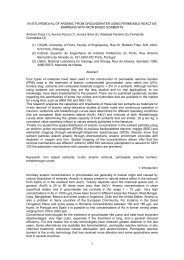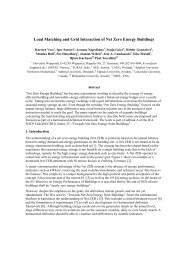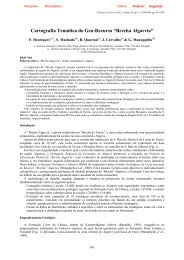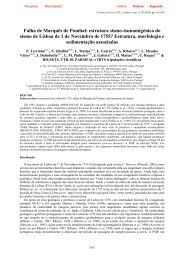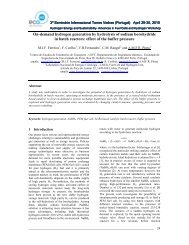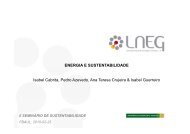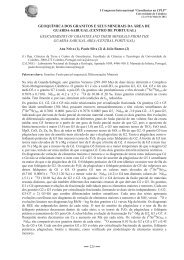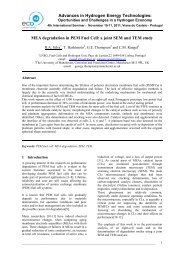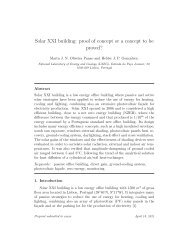Automotive Sector<strong>Car</strong> <strong>Component</strong>sphase and is basically related with the HDPE production,diesel production and PP production (in the alternative scenario).The PM 10 emissions are also greater in the productionphase for the reference scenario and similar in the productionand use phases for the alternative scenario. Thispollutant concerns the steel production and the production<strong>of</strong> fuel consumed in the use phase.Fig. 8: Cumulative life cycle water emissions for reference and alternativescenariosare higher in the reference scenario when compared to thealternative scenario. The carbon dioxide (CO 2) emissions,both in the reference and in the alternative scenarios, are416 g/component and 274 g/component, respectively. Thisproportion is in agreement with the proportion obtained forthe energy consumption (see Fig. 5) and with the large use<strong>of</strong> carbon-based fossil fuels (petrol and diesel). It could beverified in this study that the use phase accounts for themajority <strong>of</strong> the life cycle air emissions <strong>of</strong> CO, NO x and CO 2 ,since these parameters are mostly related with fuel productionand fuel combustion that occurs in this phase. The SO xemissions are greater for the production phase in both scenariosand are mostly related with electricity production,processes occurring in refineries (like the burning <strong>of</strong> residualoil) and with PA66 production in the alternative scenario.The NM VOC emission is also greater in the productionThe cumulative life cycle <strong>of</strong> waterborne emissions <strong>of</strong> undissolvedsubstances, oils, COD and BOD5 are shown in Fig. 8.The undissolved substances include also suspended substancesand suspended solids. The undissolved substancesand the COD parameters are greater for the alternative scenario.Otherwise, the oils and BOD5 parameters are greaterfor the reference scenario. This study reveals that the productionphase is the dominant source for these pollutantswith the exception <strong>of</strong> BOD5, where the main source is theuse phase due to fuel (petrol) production. The undissolvedsubstance emission is basically related to the crude production(for later plastics production), POM production (in thereference scenario) and to PA6.6 production (in the alternativescenario), and to diesel and electricity production. Forthe oil emission, the crude oil transport and the production<strong>of</strong> diesel are the largest sources. Concerning the COD, it isemitted essentially during EPDM and electricity productionprocesses (for both scenarios) and during the PA6.6 productionprocesses (for alternative scenario).Considering the above inventory results, the alternative scenarioseems to be environmentally preferable to the referencescenario.4 <strong>Life</strong> <strong>Cycle</strong> Impact <strong>Assessment</strong>The results <strong>of</strong> the life cycle impact assessment obtained usingthe problem-oriented approach CML 2000 [8;9] withimpact categories defined at a mid-point level are presentedabioticdepletionglobal warming(GWP100)ozone layerdepletion(ODP)human toxicityfresh wateraquatic ecotox.marine aquaticecotoxicityterrestrialecotoxicityphotochemicaloxidationacidificationeurtrophicationFig. 9: Comparative LCIA results for reference and alternative scenarios using the CML 2 baseline 2000 method/West Europe 1995/CharacterizationInt J LCA 12 (5) 2007 343
<strong>Car</strong> <strong>Component</strong>sAutomotive Sectorabioticdepletionglobal warmingozone layerdepletionhuman toxicityfresh wateraquatic ecotox.marine aquaticecotoxicityterrestrialecotoxicityphotochemicaloxidationacidificationeurtrophicationabioticdepletionglobal warmingozone layerdepletionhuman toxicityfresh wateraquatic ecotox.marine aquaticecotoxicityterrestrialecotoxicityphotochemicaloxidationacidificationeurtrophicationFig. 10: LCIA results for reference scenario using the CML 2 baseline2000 method/West Europe 1995/Characterizationin Fig. 9, 10 and 11. This method led to the conclusion thatthe alternative scenario is environmentally preferable comparedwith the reference scenario. The values obtained forall the impact categories are smaller in the case <strong>of</strong> the alternativescenario.The use phase in the reference scenario is the phase whichhas the greater contribution for the abiotic depletion andglobal warming. That is due mainly to fossil fuels extraction(crude, coal and natural gas) for petrol production, andto CO 2 and N 2 O emissions during the car use. The use phasealso has a main contribution for photochemical oxidation,acidification and eutrophication, which is justified by thegreat quantities <strong>of</strong> CO, SO 2 and NO x emitted as a result <strong>of</strong>petrol production and combustion. For the other impactcategories, the production phase is the main contributor. Thesame conclusions can be drawn for the alternative scenario,which exhibits a similar environmental pr<strong>of</strong>ile (see Fig. 11).5 InterpretationThe use phase has a great contribution to the global environmentalimpact. Therefore, the method used to evaluate theimpact <strong>of</strong> this life cycle phase, and particularly the 'use phase'allocation procedure, is very important. Thus, a sensitivityanalysis was conducted using a different fuel consumptionreduction value (c), in the incremental method. In this study, ac value <strong>of</strong> 0.6 is used as proposed by EUCAR 1998 [12]. Consideringthe existing references to other values, a sensitivityanalysis was performed using the fuel consumption reductionvalue suggested by Keoleian, c=0.438 [2]. In such a case, afuel consumption over the life cycle is obtained <strong>of</strong> 0.0587 kgfor the reference situation and <strong>of</strong> 0.0391 kg for the alternativecomponent, which results in a decrease in environmental impactduring the use phase for both scenarios. Therefore, thereference scenario still has a greater environmental load whencompared to the alternative scenario.Fig. 11: LCIA results for alternative scenario using the CML 2 baseline2000 method/West Europe 1995/CharacterizationTo evaluate the environmental impacts, a sensitivity analysiswas performed using an alternative method, which is accordingto the ISO 14042 recommendation. Eco-indicator 99 [10],as an endpoint-oriented approach, was used for that purpose.Results obtained converge with the conclusions achieved withthe CML method, i.e. the alternative scenario has a lower environmentalimpact than the reference scenario. The alternativescenario exhibits lower results for all the impact and damagecategories considered in this method.The sensitivity <strong>of</strong> the results with respect to the end <strong>of</strong> lifescenario was also tested, taking into account the ELV Directive[14]. It was considered, for both reference and alternativeproducts, that 80% <strong>of</strong> the steel components are recycledand 20% are landfilled and 100% <strong>of</strong> the plastics arelandfilled. The impact assessment led to the same conclusion:the results obtained for the alternative scenario arelower than those obtained for the reference scenario for allthe impact categories. The differences between this final disposalscenario and the studied final disposal scenario arevery small; the highest difference is for fresh water aquaticecotoxicity impact category and is circa 2% and 2.5% forthe alternative and the reference product, respectively.6 ConclusionsBased on the inventory analysis and the impact assessmentresults, the following main conclusions can be drawn:– the changes on washer, poppet and poppet-retainer materialsand the change <strong>of</strong> the production process to amore integrated one (which eliminates some productionsteps) result in a multimaterial car component which isenvironmentally better than the existing one, mainly dueto the reduction in component mass and, consequently,in the reduction in fuel consumption and resources consumption(crude and minerals).344 Int J LCA 12 (5) 2007





